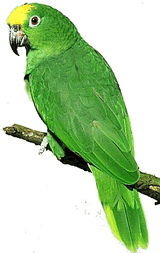
There’s a story that in 1799 the German naturalist and explorer Alexander von Humboldt (1769–1859) was exploring the Orinoco and Amazon rivers and documenting the languages and cultures of the tribes he encountered there. While spending time with one tribe of Carib people, he asked them about their neighbours and rivals, the Maypure, who he was keen to visit. He was told that the Maypure had all been killed recently by the Carib tribe he was visiting, however they did have a couple of the Maypure’s pet parrots who spoke some of their language. Von Humboldt took the parrots back to Europe and transcribed their words – the only record we have of the Maypure language, which is also written Maypure, Maipure, Maypore or Maypore’. There seems to be some doubt whether this story is true: there is no mention of the parrots in von Humboldt’s meticulous journals, but there are phonetic transcriptions of the Maypure words he heard on his travels.
In 1997 an American artist called Rachel Berwick made an art installation entitled May-por-e’ consisting of a large cage containing Amazonian plants and parrots who had been taught to speak the remnants of the Maypure language.
These two anecdotes were related by David Crystal at a fascinating talk about language death he gave yesterday at Bangor University. He used the first one to illustrate how languages can disappear completed if they are unwritten and undocumented. We only know something about Maypure because of the parrots, but in many cases once the last speaker of a language dies it is as if that language never existed.
The second story shows how the message of language death can be powerfully portrayed through the arts. Professor Crystal believes that this is the best way to make ordinary people aware of the issue. Linguists can document languages, and advise on revival and revitalisation efforts, but these are intellectual pursuits that do not engage the emotions, while art, music, drama and other artistic works appeal to the heart rather than the head. He finished his talk by performing part of a play he wrote entitled “Last Speaker”, which tackles language death, and he suggested that we tell any artistic types we know about this phenomenon and that we encourage them to create pieces related to it.
Yesterday evening I mentioned the talk to a friend and talked about it a bit. She thought that endangered languages are confined mainly to remote parts of Africa and was surprised to learn that there are endangered languages on every inhabited continent.
I love that they managed to extract part of the language from the parrots, that’s fantastic, sounds like something out of a movie (remember the James Bond movie where the girl’s father, who was assassinated, has a parrot that repeats some vitally important clue it learn from him? For Your Eyes Only I think it was, the one with the crossbows).
Cheers,
Andrew
If someone tried to learn language from my parrot, they would surmise that all we ever said to each other were ‘where’s Sean’, ‘time for bed’, and ‘shut up Ziggy’. Good story about Humboldt though.Liz
This was referenced to (?) in the Tintin album “Red Rackham’s Treasure”, in which some jungle parrots had preserved the swearwords used by Haddock’s ancestor centuries earlier:
http://www.metabunker.dk/wp-content/uploads/rackham_peroquets.jpg